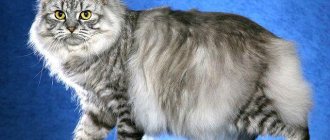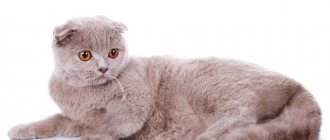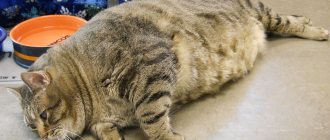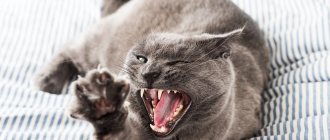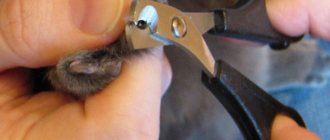At what age can you knit tartan?
The first heat in Scottish cats, like in other cats, should be expected at 8 months. However, the body has not yet finished growing, and early pregnancy can undermine the health of the pet. And the offspring of a precocious mother will not be in good health.
Scots are considered large pets, so they are ready for the first mating later than cats of smaller breeds. The optimal age for the first pregnancy is one and a half years.
A partner for the Scottish female should be looked for several months before the intended mating, preferably not far from home, in order to have time to connect the couple on the 2nd or 3rd day of estrus.
General information about the duration of gestation
On average, the question “how long does a cat stay pregnant?” The most frequently heard answer is 2 months. However, this is a rather loose concept - some individuals barely carry their offspring to term for up to 60 days, and for some the process can last up to 70. According to general estimates, the minimum gestation period for cats is from 56 to 60 days, the maximum normal is considered to be 71 days (some sources give 72 days). These are periods when the birth of viable offspring is allowed. Most often - 64-67 days (roughly rounded, it comes out to 9 weeks).
The entire “pregnant” period is conventionally divided into 3 phases of development, each of which on average includes 3 weeks.
1 phase
This period lasts from the moment of expected conception to 21 days. During this period, eggs are fertilized and embryos develop. By the 15th day, the embryo already becomes up to 1 cm in size, by the 18th day the paws appear, and by the end of the period the internal organs are already formed. It is in this phase that active pinking of the nipples is observed.
2 phase
During this period (from 22 to 42 days), the brain, skeletal structure, muscles and endocrine system are actively formed and developed. From this point on, the kittens are called fetuses, taking on the classic feline appearance with a clearly defined muzzle and genitals. Only after a month of pregnancy the cat’s belly begins to grow a little.
3 phase
On days 43-63 from the moment of conception, kittens, growing to 8-10 cm, acquire a tail and acquire a coat with a certain color. By the middle of the period, their size reaches 13 cm, by the 57th day they are already fully formed and developed babies who are ready to be born at any moment.
There are exceptions to all rules. The duration may vary depending on many factors:
- offspring of purebred individuals born before 60 days are most often non-viable;
- cats with a slender constitution (subtle) usually never go pregnant longer than 65 days (on average it is 60-65 days), and fat and well-fed ones usually carry a pregnancy and the period can reach 70-72 days;
- primiparous cats, especially those who become pregnant during their first heat before the age of 1 year, in most cases give birth earlier than the expected average period (up to 60 days). Kittens are not always born viable and are often weak and small. That is why experienced breeders do not recommend mating a cat to produce offspring in the first heat and under the age of one year;
- primiparous middle-aged cats bear their offspring somewhat longer than their female peers who have given birth;
- yard outbred cats bear less fruit than domestic and special breed cats. Sometimes healthy babies are born on the 55th day - this indicates better endurance and higher adaptability of street individuals compared to domestic ones;
- in a fold cat (British, Scottish), kittens are gestated for an average of 63-67 days, but almost never less than 60 days;
- cases of nursing up to 75 days have been recorded. The course of the entire period was without complications, and the newborns were all alive and well. The reasons for such a long but safe gestation are still a mystery to veterinarians;
- Pregnancy of the Maine Coon breed is usually longer than that of other breeds - up to 68 days or 9 full weeks in preparation for the birth of the cat herself;
- long-haired cats stay pregnant longer (up to 70 days) than smooth-haired or completely hairless cats (around 65 days);
- the fewer fruits there are in the litter, the longer the cat can go pregnant and, conversely, the more, the faster and more often the birth will occur before the due date;
- weather conditions affect the onset of labor - sudden changes in temperature and environmental humidity can suddenly trigger premature birth;
- The pregnancy of a Scottish cat is usually shorter than that of a British cat, in which the pregnancy period can sometimes increase to 70-72 days. Therefore, there is no clear answer to the questions of how long pregnancy lasts in a Scottish cat or how long pregnancy lasts in a British cat - variations in duration are present here too.
Signs of pregnancy in Scottish cats
After mating, the cat calms down and becomes imposing. If the pet does not have contact with other animals at this time and eats according to its needs, the onset of pregnancy proceeds without problems. The first signs of pregnancy are observed 2-3 weeks after conception. The cat, as well as the woman, experiences attacks of morning sickness, characteristic of toxicosis of pregnancy.
The pet's nipples begin to turn pink, and the hair around them gradually falls out. However, such changes are individual and ultrasound is a reliable test for pregnancy. The first examination is usually carried out 3 weeks after mating.
Be sure to read:
Pregnant Sphynx cat: how to find out about the position, changes in behavior and appearance, how long they walk
Even an inexperienced owner can determine that the cat is pregnant in the sixth week of gestation.
By this time, her belly is rounded, her nipples swell, and her mammary glands enlarge.
Features of the first lambing
When a Scottish cat gives birth for the first time, she does not always understand her condition. The animal may experience panic. Such births, as a rule, are always more difficult than all subsequent ones. Complications often occur.
If a Scottish cat gives birth for the first time, she runs after her owner, meows and asks for help. You need to calm the animal, talk to it, stroke it, and take it to the prepared nest. Sometimes you have to do this several times as the expectant mother comes out of the box and starts running again.
It happens that a cat does not feed newborns or care for them. You shouldn’t be afraid of this behavior of the animal, it’s just that the necessary hormones have not yet been produced in the body. The babies need to be placed close to the nipples, and until the mother begins to lick them, sit next to the cat family.
Important! If the Scottish Fold's first pregnancy continues for 70 days, you should urgently consult a doctor.
Behavior of a pregnant fold cat
A pregnant cat changes its behavior. Hormonal surges change behavior. The cat alternately pets and looks irritated. Fetal development increases food requirements during the fourth week of pregnancy. At that time, the feed portion can be increased by 10-15%. In subsequent weeks, the animal is no longer restricted in food, but in order to avoid overeating, it is fed in small portions, but often.
The best option is to switch to ad libitum feeding with dry granules. The fifth week of pregnancy has only just begun, and the Scotswoman is already beginning to nest: she is looking for a secluded place. If the owners are planning to purchase a cat house, then this time is most suitable for the implementation of the intention.
During the seventh week, the cat may lose its appetite for a while. The embryos begin to grow fur and the cat hibernates at this time. The body is rebuilt, some of the nutrients are redirected into the formation of fruits to prepare the mammary glands for lactation. This process requires calmness, so the cat becomes drowsy.
In the last weeks before lambing, the Scotch cow becomes active again, once again walking around the property in search of a more convenient nest. It's time to satisfy your curiosity and repeat the ultrasound. You can determine the number of fruits and observe their movements. However, someone may be undetected and the actual number of kittens turns out to be greater than expected.
What owners should do and what not to do to preserve the gestation period of their offspring
In order for the cat to emerge within the prescribed period, the owners need to know several rules about what should be done and what should be avoided during this period, so that the duration does not change towards critical. Rules are not a panacea, because There is also a genetic predisposition, which “you can’t argue with.
What do we have to do:
- Contact a specialist as soon as possible after the expected conception to identify possible risks to the life and health of the fetus and for the mother cat. It is wise to use an ultrasound to find out if the cat is pregnant at all.
- Contact your veterinarian if Murka exhibits any strange behavior or changes in health (vomiting, fever, lack of appetite).
- Protect the pet from children so that they do not squeeze, kick or make any sudden movements towards the animal.
- Provide balanced and sufficient nutrition.
- If necessary, give vitamins for pregnant women (veterinary).
What not to do:
- Make Murka nervous. This includes purchasing new pets during this period, arranging noisy events indoors where the cat cannot hide, and allowing children in.
- Press the stomach tightly, supposedly trying to determine how many babies should be born. It is almost impossible to do this with your hands, especially for a non-specialist, and it is easy to injure the abdomen!
- Give any medications without consulting a veterinarian.
- Allow Murka to jump from a height or climb there.
- Washing or treating your home with strong and strong-smelling household chemical solutions is a direct path to poisoning.
- Allow contact with sick and abandoned animals.
- Do not follow the rules of hygiene (stroking with dirty hands after going outside or allowing you to sleep in the shoes you came in from the street in).
What to feed a pregnant Scottish Fold cat
No special food has been developed for pregnant and lactating cats. Manufacturers of ready-made food believe that the nutritional needs of a mother cat are the same as those of kittens. Therefore, it is recommended to switch a pregnant pet to baby food from the moment pregnancy is considered established.
Be sure to read:
Can a cat have one kitten if the fetus is in the birth canal, what to do
That is, if on the 25th day after mating an ultrasound showed the presence of embryos, the pet begins to gradually replace the previous food with a new one. This should be done gradually over a week to prevent feeding stress, which will negatively affect the fruit.
If an ultrasound was not performed for some reason, the transition to a new food begins when pregnancy is established based on other signs.
Malyshovsky food is as close as possible to milk in terms of energy and protein concentration, therefore it contains a lot of fat. For this reason, it should not be given immediately after mating, since Scottish females are prone to obesity.
The best option is universal holistic food such as Acana or Orijen, or specialized food Royal Canin Mother & Babycat. Adherents of natural food should create a diet that is not inferior in nutritional value to the indicated ready-made food.
Nutrition
In the first weeks of pregnancy, the Scottish cat eats as usual. But in the later stages, the pet gradually refuses frequent meals because... kittens grow and take up all the space in the stomach. In this case, you should reduce the diet, but give portions more often 4-5 times a day.
For a pregnant cat, not just a proper diet is important, but also one rich in minerals and vitamins . It would be a good idea to add special vitamin complexes to the bowl, which can be purchased at the pharmacy.
If your cat's diet consists of dry food, it is recommended to gradually add canned food for kittens to the bowl. By the end of pregnancy, the menu should preferably consist of canned food. When eating natural foods, experts recommend including the following foods in your diet:
- boiled meat (about half of the diet);
- boiled vegetables;
- eggs;
- small portions of lean boiled fish (in no case sea fish!)
To improve the functioning of the digestive system, it is recommended to add beet puree to the diet.
To actively produce milk, you can feed your cat a salad of scalded nettle leaves. To facilitate childbirth and prevention, you can give a decoction of raspberry leaves. Twice a day - morning and evening.
How to help a Scottish woman during childbirth
The first aid before lambing is preparing the den. The simplest option is a cardboard box with holes cut for ventilation, lined with paper and covered with a soft cloth. The future house for kittens is placed in a secluded place. The nesting cat is picked up and placed in a prepared place. If the cat shows willfulness and lambs in another place. She, along with her offspring, is placed in a prepared den, from which she will never leave.
Be sure to read:
Miscarriage in a cat: symptoms, reasons, what to do, why kittens are born dead
It is good if a veterinarian is present during the birth, but most owners can provide assistance on their own. Most often, the cat copes on its own.
Labor begins with the release of amniotic fluid. The kitten is born in the amniotic sac, which bursts and the cat gnaws the umbilical cord. If she did not do this, you need to cut the cord with sterile scissors and treat the stump with tincture of iodine. The mother usually eats the placenta. This is normal, but you should not allow more than two placentas to be eaten. When the cat has the intention of eating another afterbirth, food is added to it.
If the bubble does not open on its own, it is broken with your fingers. The kitten is shaken, the liquid is removed from the mouth with a baby syringe and placed on the mother.
The normal interval between the births of kittens is considered to be a quarter of an hour. All afterbirths come out within half a day after the birth of the last kitten. If labor is difficult, call a veterinarian.
Character
The disposition of Scottish Fold cats will bring joy to all family members, from children to grandparents. After all, as kittens, the Scots cannot sit still, haunting the family and touching you with their funny games, and with age they begin to lead a measured and calm lifestyle, sacrificing a bowl of food for the opportunity to lie in a corner on the sofa. But most of all, the fold-eared cat likes to be close to others, and it doesn’t matter whether it’s a person or an animal.
She will love your knees with great pleasure and will lick your hands or face, because she is, perhaps, one of the most affectionate cats.
Kitten playing with parrots
If you have other animals at home, for example, a dog, a rabbit or a hamster, then you can rest assured that they will become your lop-eared best friends. Also, these extraordinary cats are very easy to transport, because they do not panic and are not afraid of closed spaces.
And the last, perhaps the most amazing feature of Scottish cats is that they have a certain intelligence.
Tartans are trainable
These animals are highly trainable, quickly learning to use a litter tray and use a sharpening board to sharpen their claws. Therefore, if you value cleanliness and order in your home, get an intelligent Scottish Fold kitten.
Pet care
During pregnancy, a cat needs good nutrition, care, and attention. The diet must be balanced, taking into account the condition of the pet. You need to add vitamins or switch to special food.
A balanced diet is important
Attention! It is important to increase the number of meals rather than the portions, since fruits take up a lot of space and put pressure on the stomach. The cat can no longer eat much at one time.
Do not forget to periodically show your cat to the veterinarian, even if she feels well. This way you can eliminate potential troubles in a timely manner or simply make sure that everything is in order.
Closer to childbirth, you need to prepare the necessary tools in case you need help. You also need to help the animal find a secluded place. Just put a box for her or arrange a bed in a semi-dark place, put a soft bedding.

